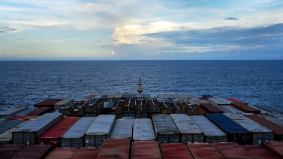On August 9, 2024, a shocking fire and explosion incident occurred at the Port of Ningbo-Zhoushan in Zhejiang Province, involving the Liberian-flagged container ship M. The accident caused significant economic loss and once again raised alarm bells over the safety of hazardous cargo transportation. This article provides an in-depth analysis of the causes based on the latest report issued by the Maritime Safety Administration titled “Investigation Report on the August 9th ‘M’ Vessel Fire and Explosion at Ningbo”, and offers safety management recommendations.
Overview of the Incident
The incident took place at approximately 13:46 on August 9, 2024. While the Liberian-registered container ship M was operating at Berth No. 2 of the Beilun Second Container Terminal of Ningbo-Zhoushan Port Co., Ltd., a fire and explosion occurred in a container located on the starboard side of Cargo Hold No. 1. The explosion damaged multiple nearby containers and parts of the vessel, with direct economic losses estimated at approximately 90 million yuan.
In-Depth Analysis of the Cause
· Cargo Factors
The cargo involved was tert-butyl peroxybenzoate (TBPB), an organic peroxide known for its thermal instability. It can decompose exothermically at room temperature, releasing large amounts of heat and generating gas or vapor. In this case, TBPB was stored in a non-powered refrigerated container. Due to the container’s excellent insulation and airtightness, heat could not dissipate effectively. This near-adiabatic and sealed environment caused heat to accumulate continuously, eventually triggering thermal runaway, which led to the fire and explosion.
· Environmental Factors
The incident occurred during the peak of summer, with daytime temperatures in Shanghai and Ningbo reaching around 40°C. The extreme heat further destabilized TBPB and significantly increased the safety risk during transportation.
· Management Factors
Carrier Responsibility:The carrier failed to exercise due diligence when reviewing the cargo transportation plan. It did not properly assess the risks associated with high ambient temperatures, the cargo’s self-decomposing nature, and the thermal insulation properties of the non-powered reefer container. Approving the use of such a container for TBPB was a clear oversight.
Shipper Responsibility:The shipper also failed to fully consider the high temperatures and the characteristics of the non-powered reefer container. The risk of thermal runaway was not adequately evaluated, leading to an inappropriate choice of transport method.
Incident Response and Emergency Measures
Following the explosion, the Ningbo Maritime Search and Rescue Center promptly activated emergency plans and coordinated multiple parties to respond. Measures included maritime traffic control, evacuation, expert guidance, and coordinated fire suppression from both land and sea. The fire was effectively contained, preventing secondary disasters. There were no casualties, showcasing a highly professional and efficient emergency response.
Losses and Impact
The explosion caused several containers on board the M vessel to disintegrate, be ejected, or burn. Parts of the vessel were damaged and deformed. The incident also disrupted normal port operations and had some impact on the surrounding environment.
Safety Management Recommendations
Based on the issues exposed in this incident, the following recommendations are proposed:
1) For Carriers:
Improve the booking review system for hazardous cargo, and strictly verify safety technical data.
When selecting transportation methods for non-temperature-controlled hazardous goods, comprehensively consider factors such as ambient temperature, container characteristics, cargo loading time, and voyage duration.
Pay special attention to containers carrying organic peroxides, and, when necessary, implement additional safety measures such as regular temperature monitoring and ventilation.
2) For Shippers:
Enhance training on hazardous goods transportation, with thorough understanding of the cargo’s physical and chemical properties.
Fully consider cargo characteristics, environmental conditions, and transport arrangements when selecting shipping methods.
Strictly review safety technical data of hazardous cargo to ensure transport safety.
Conclusion
The August 9th M vessel fire and explosion at Ningbo serves as a stark reminder that there is no room for error in the transportation of hazardous goods. All relevant parties must prioritize safety risk assessment and management throughout the shipping process. Hopefully, this tragic event will serve as a catalyst for raising safety management standards across the entire industry.
(Note: All data in this article is sourced from the “Investigation Report on the August 9th ‘M’ Vessel Fire and Explosion at Ningbo.” For full details, please refer to the official website of the Maritime Safety Administration of the People’s Republic of China.)

Last
Navigation Alert! Vessel Sinks Near Port
The Maritime and Port Authority of Singapore (MPA) has reported that a Belize-registered dredger, KSE Hitachi, sank in the waters

Next
Declaration of Import and Export Goods: Latest Interpretation from Customs
To further institutionalize the achievements of customs and inspection integration and adapt to the new requirements of customs cl




